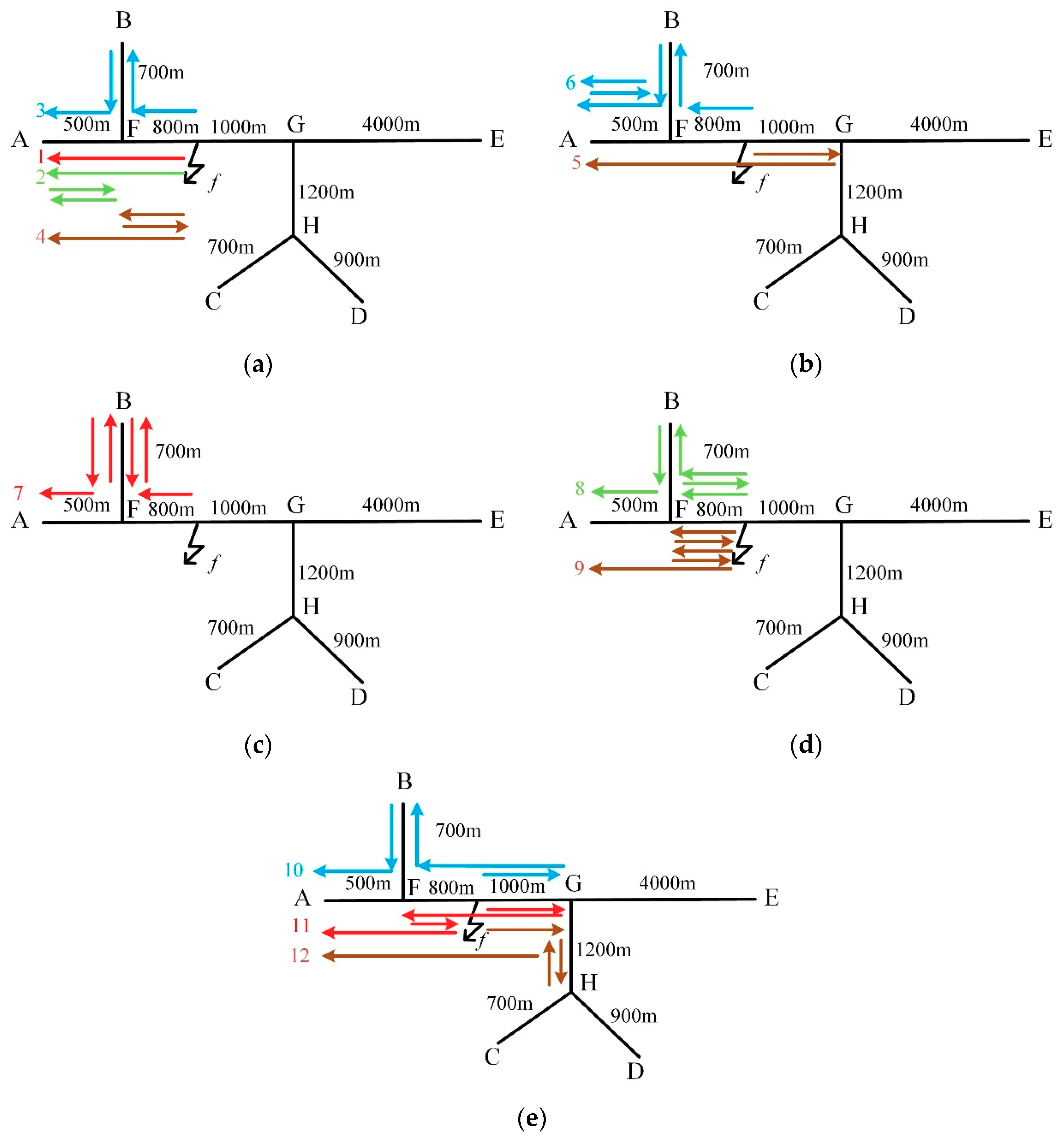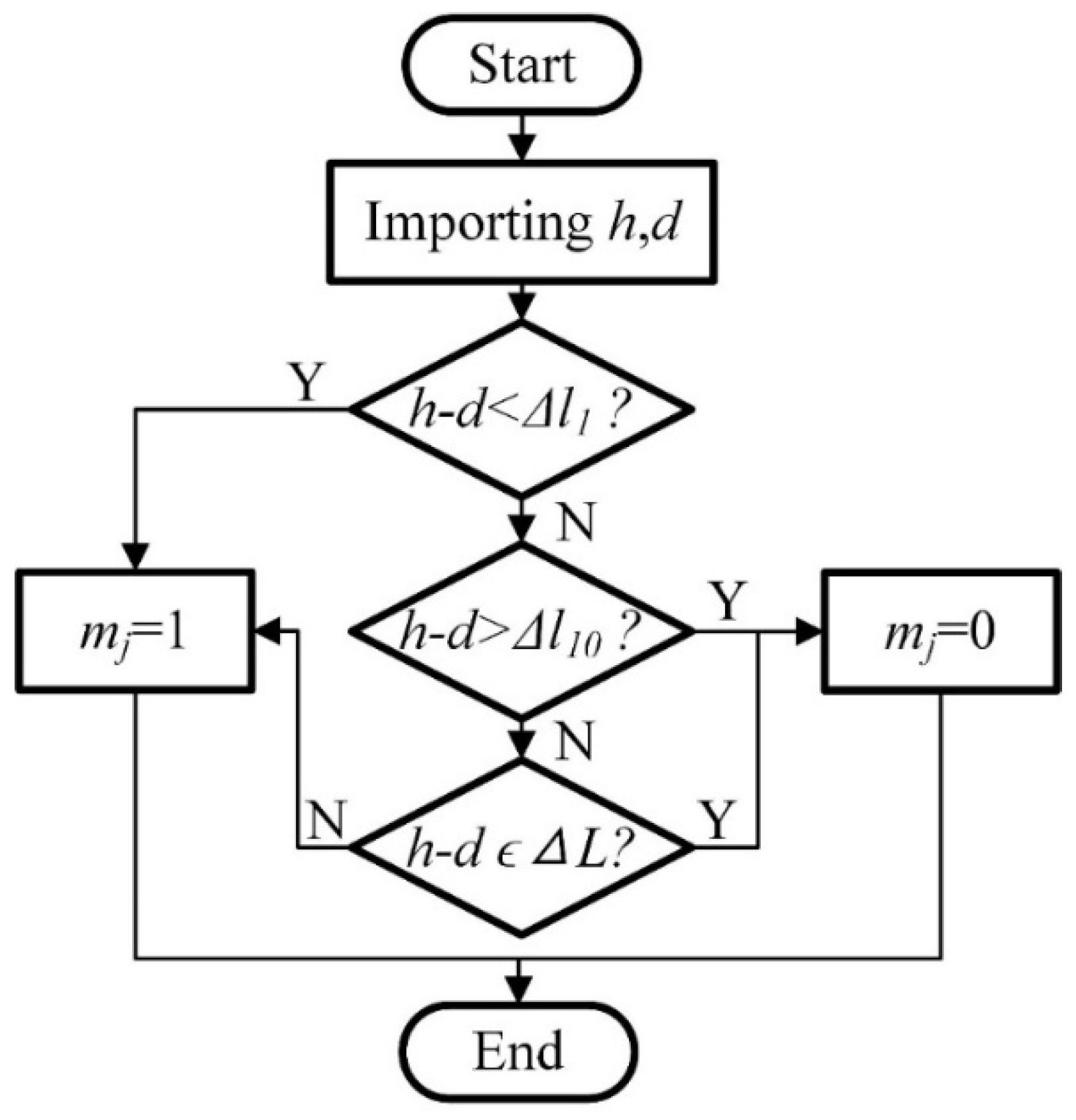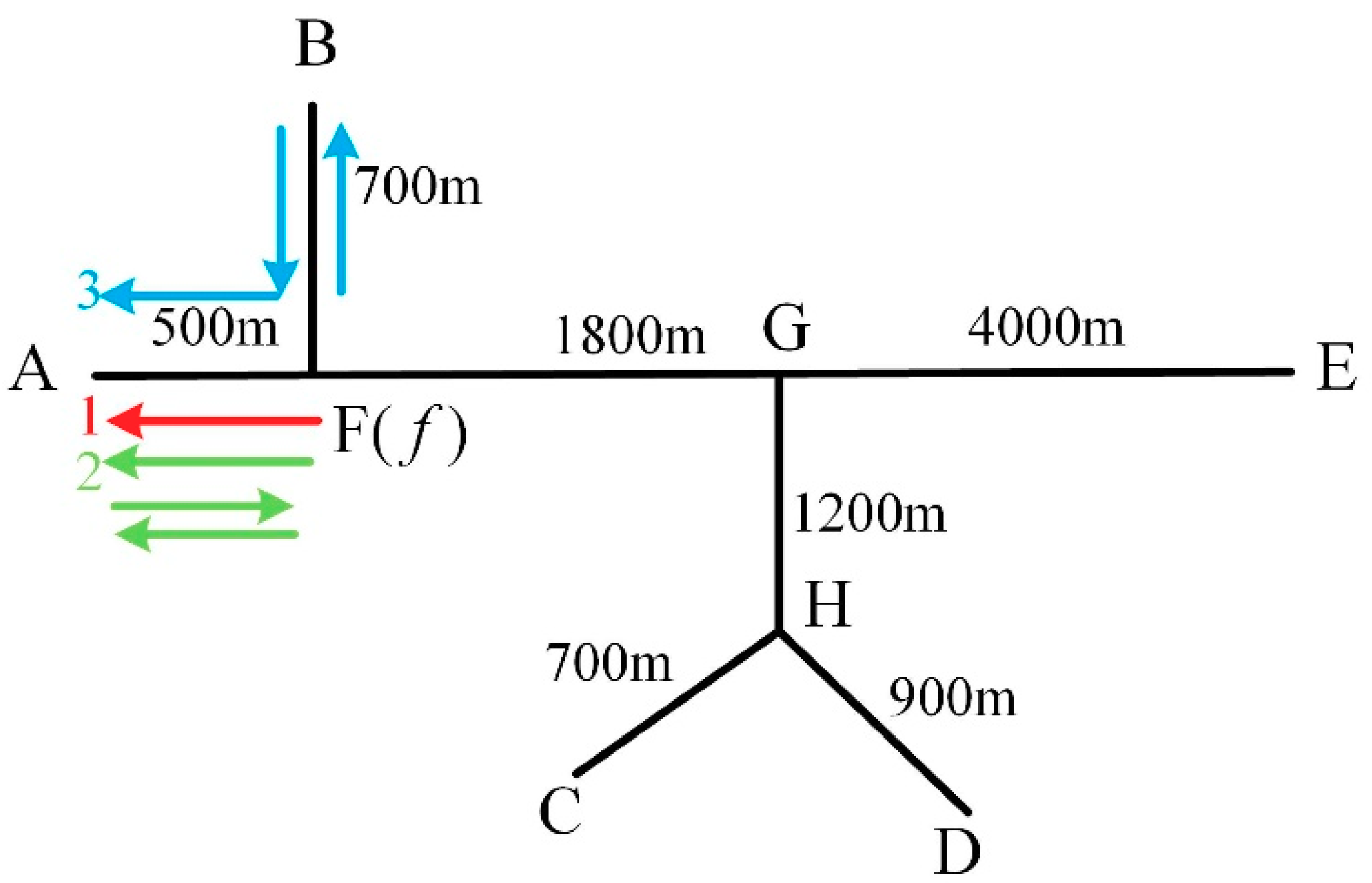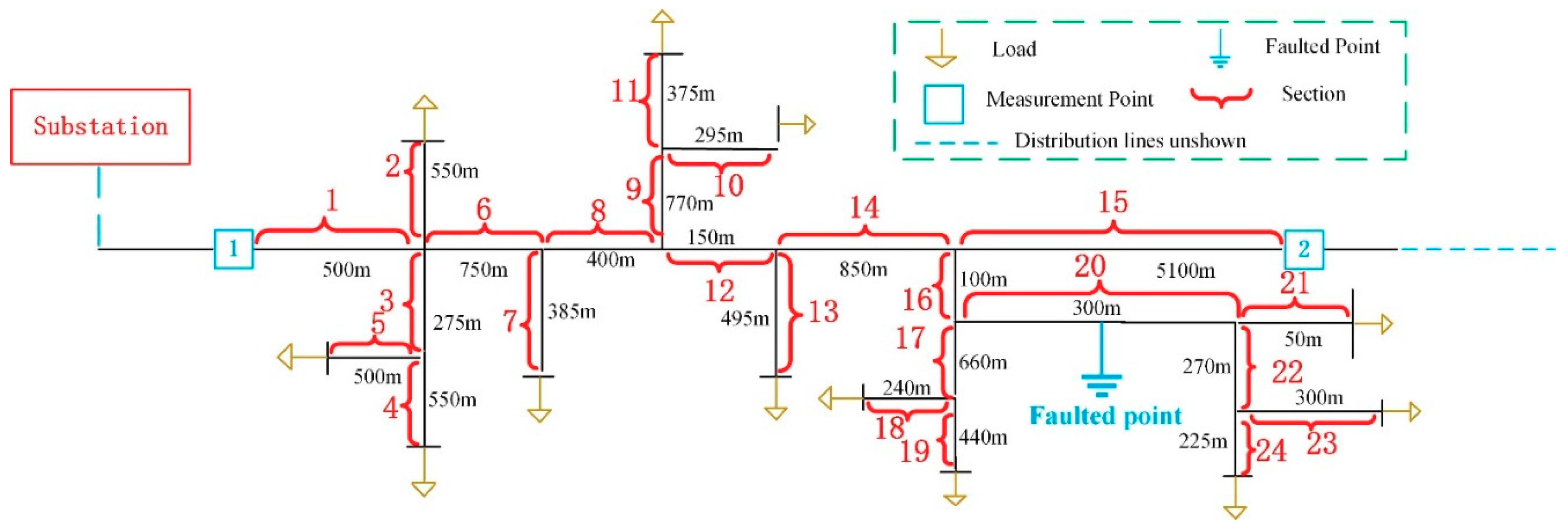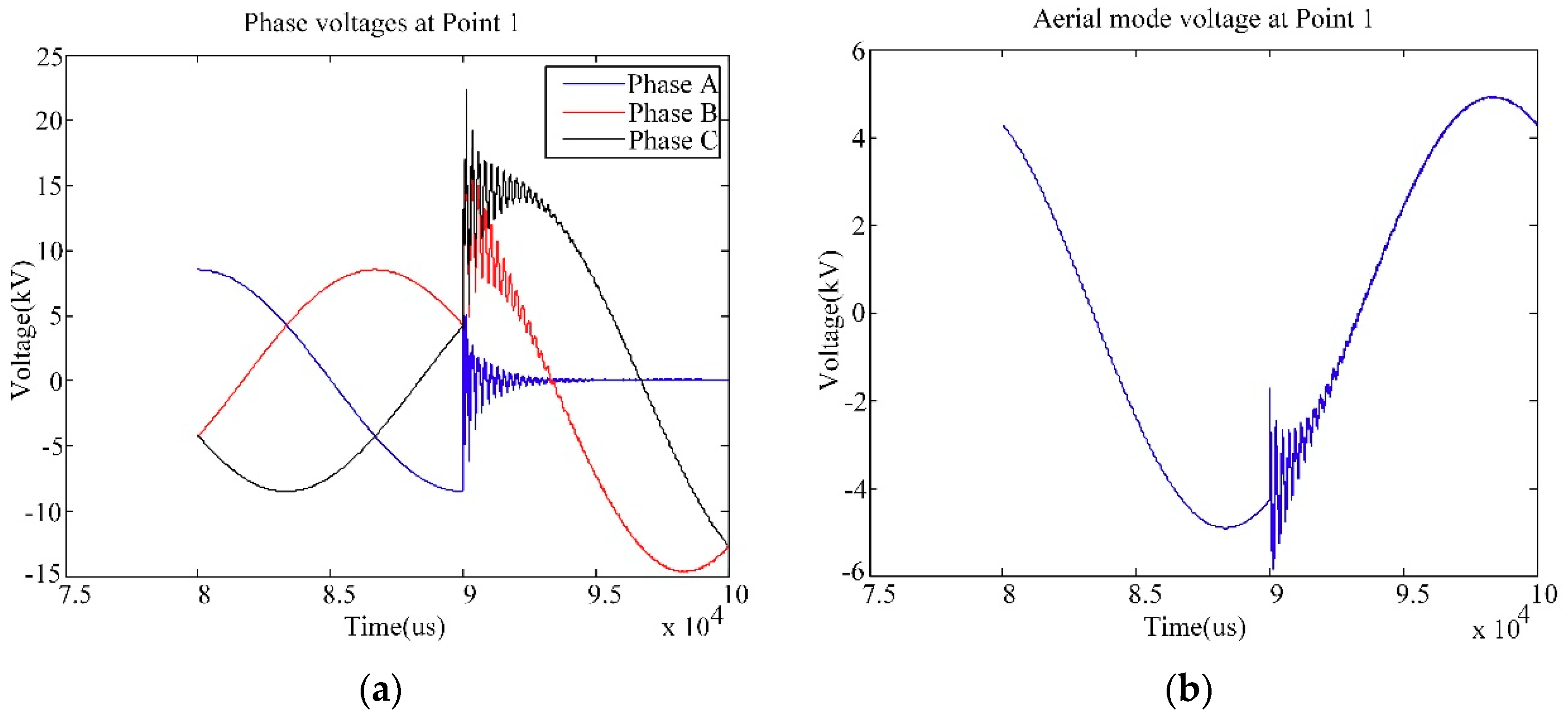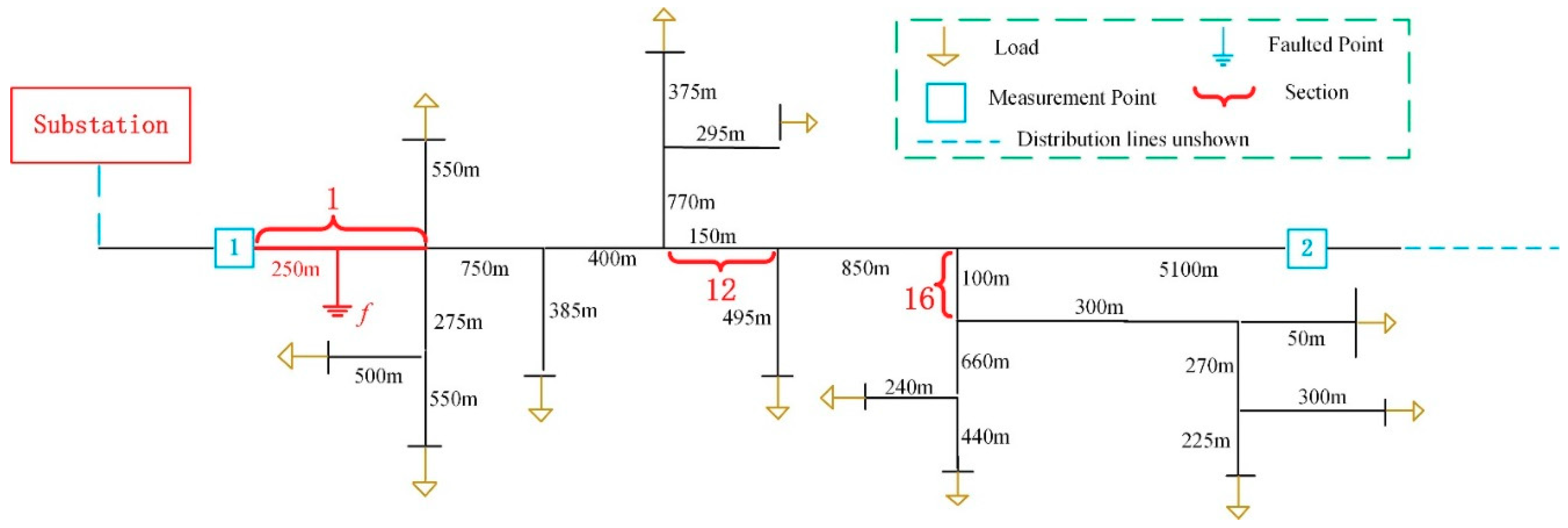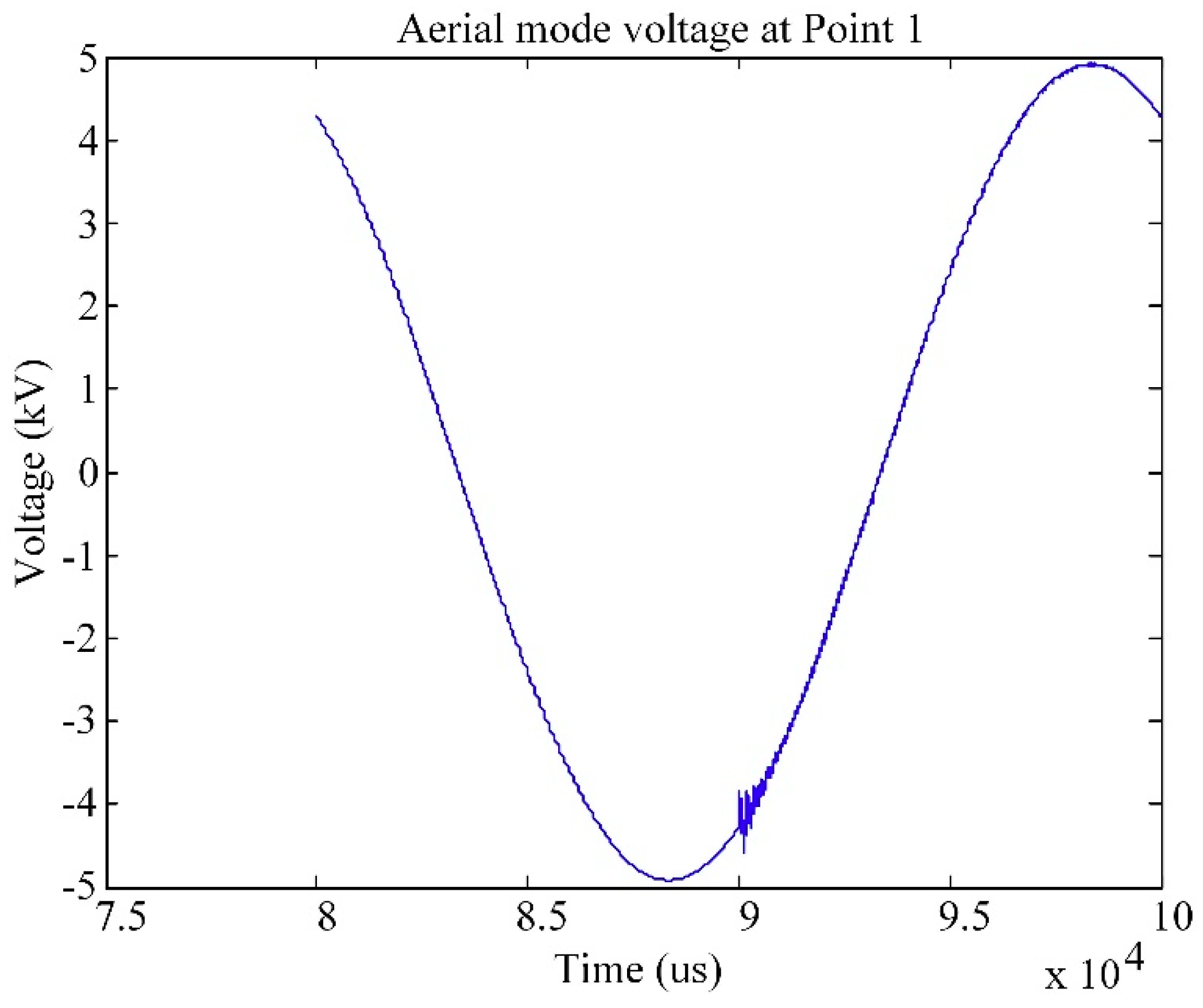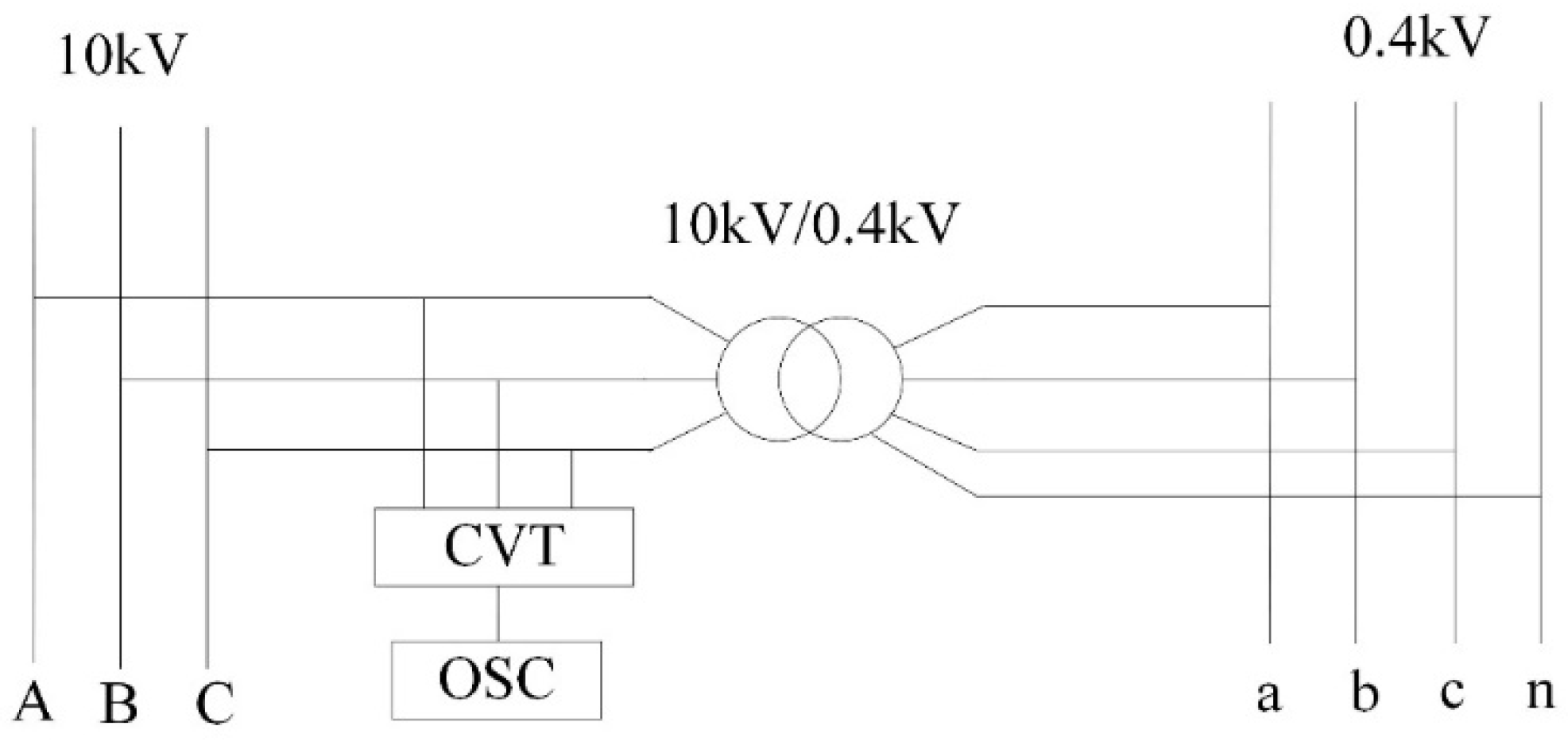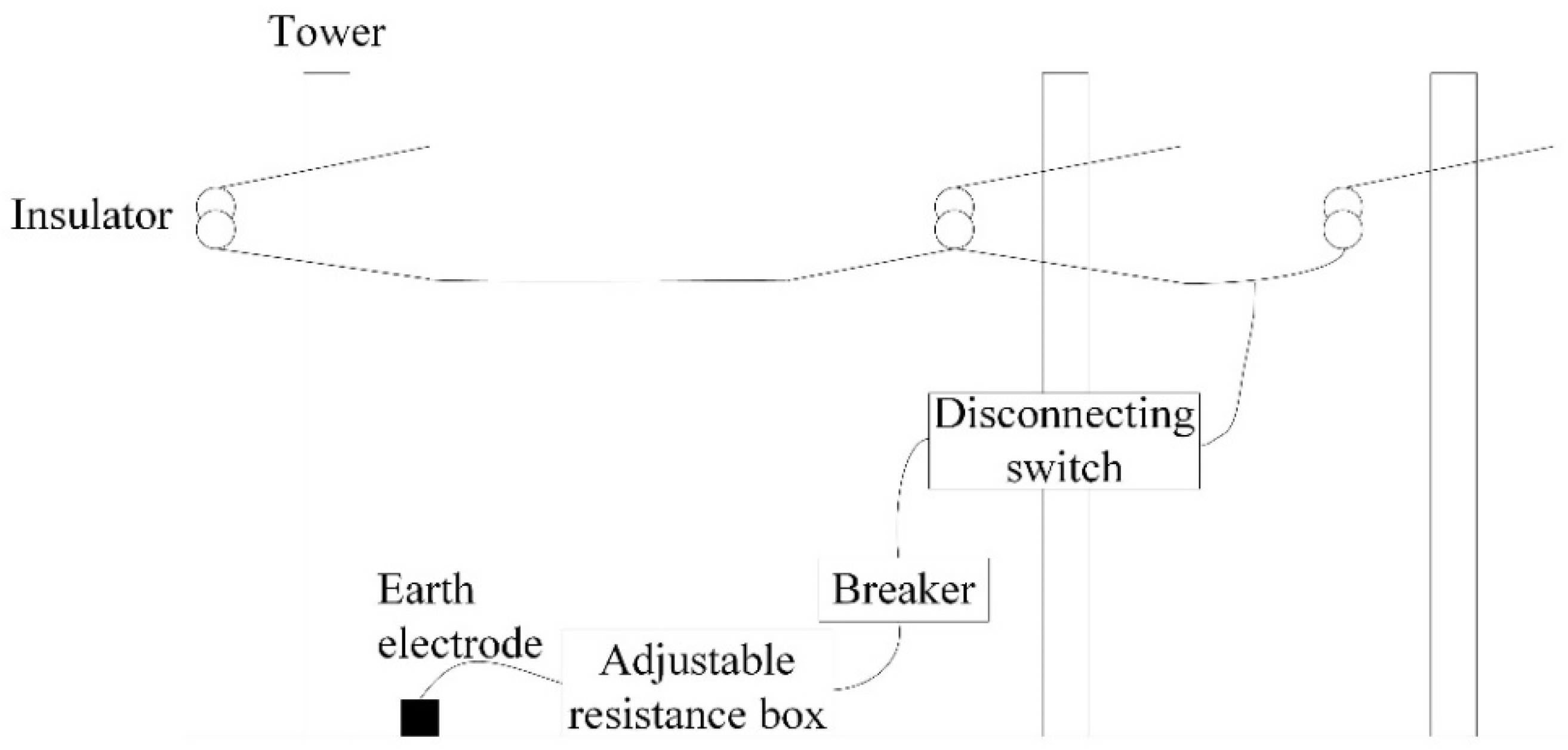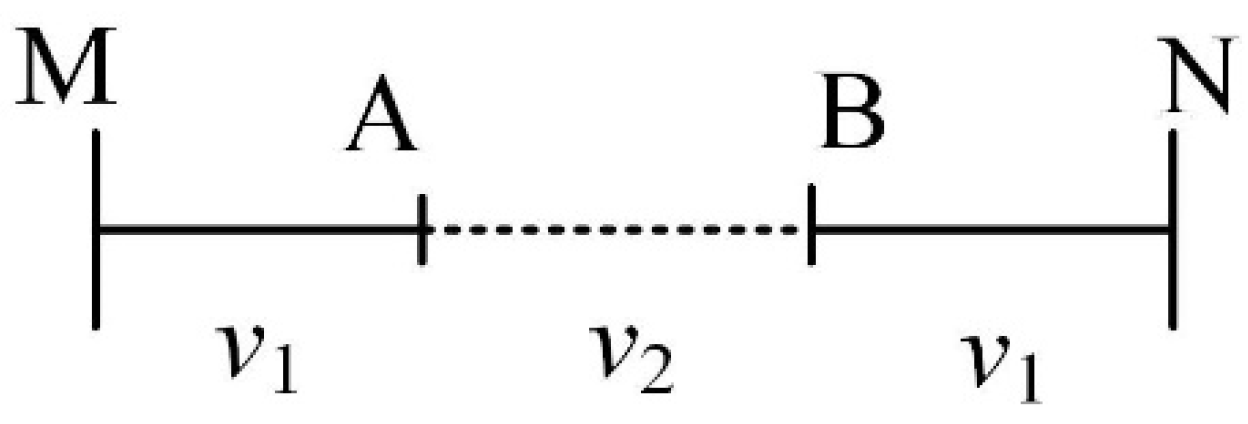In a branched distribution network, the fault-originated TW is subject to multiple reflections during propagation. If the corresponding information can be sufficiently utilized, the fault location may be determined by a single-ended TW measurement.
2.1. Propagation Characteristics of the TWs
According to the superposition principle, a power source is supposed at the fault point instantly when a single-phase-to-ground fault occurs. The fault-originated TW propagates from the fault point in both directions along the line. Multiple reflections will happen at the fault point, at the tee points (branch nodes) and the end of lines.
The measurement device is installed at the substation or at the end of the line, and the arrival time of the initial TW and its reflected versions are supposed to be detected through time-frequency techniques. Because the time of the fault occurrence is unknown, the propagation distances of the initial TW and the reflected TWs cannot be calculated. However, regarding the time slot of their arrivals, distance differences would be derived given the wave velocity, which will be the most important information used by the proposed method in this paper. The initial wave propagates directly from the fault point to the measurement point, and its distance is the shortest. Each reflected wave goes longer than the initial wave does, and its propagation path can be considered as a summation of the initial wave’s distance and the section length where reflection occurs.
Figure 1 shows the relationship between the distance differences and the length of sections. The measurement point is configured at point A which represents the substation. F and G represent the tee points and B, C, D, E represent the line ends. When a single-phase grounding fault (represented by Point
f) occurs on section F–G, the propagation paths of the initial TW and the reflected waves detected at measurement point A are depicted in
Figure 1.
In
Figure 1, the arrow lines represent the TW propagation paths. Line 1 in red color shows the direct path from the fault point to A. Line 2 in green color shows the path with reflections at F and A. Line 3 in blue color shows the path with reflections at F and B. Line 4 in brown color shows the path with reflections at F and the fault point
f. Similarly, multiple waves may be detected at measurement point A, which are reflected at other nodes, forming paths different from line 1–4.
As mentioned above, the propagation path of the reflected waves is longer than that of the initial wave. Moreover, the distance difference between the reflected wave and the initial wave is twice the length of the section where reflection occurs. For example, the relative distance between Line 1 and Line 2 is two times of the length of the section F–A, and it is section F–B for the case corresponding to Line 1 and Line 3. The same results can be drawn for the wave reflected at the fault point in the case involving Line 1 and Line 4 in
Figure 1. Generally, there are three categories of sections:
- (1)
Direct sections: they are included in or linked to the shortest path between the measurement point and the assumed fault section. For example, in
Figure 1, if F–G is assumed as the fault section, A–F and B–F are defined as the direct sections; if G–H is assumed as the fault section, A–F, B–F, F–G and G–E are all direct sections; if A–F is assumed as the fault section, then there is no direct section.
- (2)
Fault-originated sections: they are induced by the fault point. For example, if F–G is assumed as the fault section and the fault locates at f, then F–f and G–f are defined as the fault-originated sections; if A–F is assumed as the fault section, A–f and F–f are the fault-originated sections.
- (3)
Indirect sections: they are linked to the direct sections or fault-originated sections. Only if the TW is reflected on the direct section or the fault-originated section, can the reflection occur on the indirect section. For example, if F–G is the fault section, G–H is an indirect section linked to the fault-originated section
f–G, which is depicted as path 12 shown in
Figure 1e.
2.2. Principle of the Fault-Location Method
A real distribution network can be divided into many sections by tee points and line-end points. For example, in
Figure 1, the lines between two adjacent nodes are regarded as sections, forming seven sections.
In this paper, the ground and aerial mode of voltage waves were used, since voltages are easy to measure at line ends. The obtained phase voltages are decomposed into mode components through the Karrenbauer transform as depicted in Equation (1):
where
V1 and
V2 are the aerial modes and
V0 is the ground mode.
Va,
Vb and
Vc represent the phase voltages. One aerial mode voltage related to the faulty phase was used due to its stable velocity and small noise interference. For phase-C to the ground fault,
V2 was used. For all other fault types,
V1 was used.
Several time-frequency analysis methods have been developed to detect the arrival times of TWs [
28,
29,
30,
31], such as the wavelet transform and Hilbert–Huang transformation (HHT). According to [
31], the HHT is conducted through two steps: empirical mode decomposition (EMD) and the Hilbert transformation. Firstly, a series of inherent modal components (named
imf1,
imf2,…) of the aerial-mode voltage are obtained by EMD; then, the Hilbert transform is applied to the
imf1 component to explore the relationship between instantaneous frequencies (IF) and time. The first maximum of IFs indicates the arrival time of the initial wave, while other maximums indicate the arrival time of the reflected waves. A vector
T is used to represent these arrival times:
where
t0 is the arrival time of the initial wave and
are for the reflected waves. Then, time differences can be obtained with respect to
:
where
is called the
time difference. The corresponding results are represented by
:
The index n is expected to be as large as possible to achieve a better locating result, which is related to two factors. The first one is the sampling rate. The higher the sampling rate is, the more reflected waves can be detected. However, a high sampling rate is costly to implement in practice. The other factor is that the waves being reflected several times are difficult to sense due to propagation attenuation and noise interference. With numerous simulations and experimental investigations, it has shown that an appropriate choice of n is 8–10.
With the obtained arrival time differences, the path differences between the reflected waves and the initial wave can be calculated as:
where
is the
ith distance difference and
v is the wave velocity given in Equation (6) for a uniform overhead line [
27]:
where
and
are the relative permittivity and magnetic permeability in free space, respectively. In the case of overhead lines, the propagation medium is air, whose relative permittivity is 1, and the wave velocity is close to the speed of light.
The calculated distance differences are listed in
:
Obviously, fault location is closely related to the distance differences, which are described in relative values, and thus cannot be adopted straightforwardly to estimate the fault distance. However, is available to infer the probabilities of fault occurrence on each section, provided the networking information. The section with the largest probability will be regarded as the fault one.
The details to calculate the probability of a fault on each section are described as follows. Assuming that the distribution network was divided into k sections and n distance differences have already been obtained, a matrix was used to record the judgement results in the process of calculation.
Firstly, the probability of the fault on the assumed jth ( is randomly selected and ) section is calculated. It involves two steps:
- (1)
For i = 1 to n (n = 10)
Based on the structure of the network, the TW undergoes multiple propagations starting from the jth section to the measurement point, forming the shortest path of the initial wave and other paths of those reflected at different sections. Herein, the essential is to figure out the specific propagation path of the reflected TW to match the calculated as depicted in Equation (5). In detail, the “distance difference” (derived from the network topology) between the specific reflected TW path starting from the jth section and the initial TW path should be equal to (here considered as being reasonable). If all the (i = 1,…, 10) are reasonable, the hypothesis that the fault is on the jth section holds. Usually, due to measurement errors and other impacts, not all the are reasonable. However, to be sure, more reasonable leads to a highly likely hypothesis.
If the ith distance difference () is reasonable, it is indicated by Jji = 1; otherwise, Jji = 0.
- (2)
Whether the length of the fault-originated section was reasonable will be determined following the process as shown in
Figure 2.
In
Figure 2,
h is the length of the
jth section and
d is the length of the fault-originated section. Obviously, if
, the first distance difference should be
, rather than
; if
,
should be included in
; and if
, the length of the fault-originated section cannot judge whether it is reasonable. To avoid leaving out the true fault section, it is regarded as reasonable.
Thus, the probability of the fault on the
jth section is calculated as:
Secondly, changing the index j, the aforementioned two steps are repeated until the probabilities of the fault on all k sections are obtained.
As a result, the section with the maximum probability was inferred to be the fault section. It is worth noting that a couple of sections with the same maximum probability may be determined, since numerous branches exist and the single-ended information is not sufficient. In other words, the fault location can be confined within a few sections, which greatly narrow down the scope of fault inspection for maintenance staffs. It still meets the requirement of the fast checkout of the fault locations.
Furthermore, if the unique fault section is expected, a few more measurement points can be involved, which conduct the TWs measurements independently from each other.
In practice, due to the estimation error of TW velocity, measurement errors, noise interference and other impacts, the measured distance difference (
) and the length of the real section (
h) where reflection occurs cannot be exactly equal. Therefore, a certain level of deviation is allowed as in Equation (9):
where
is selected as 15 m in this paper. In other applications, adjustments will be made to achieve better results.
2.3. Implementation Process with an Example
Supposing that a fault occurs on the section F–G, as shown in
Figure 1, path 1 indicates the initial wave propagation, and the paths 2–11 represent the reflected wave propagations which are ordered from short length to long length, as shown in
Figure 1.
If the path length of the initial wave is subtracted from those of the reflected ones’, 10 distance differences are obtained (they are divided by two for easy comparison with branch lengths), as listed in
Table 1.
Then, the calculated probabilities are depicted in
Table 2, where the lengths in the first row are the distance differences, as listed in
Table 1. As discussed above, it is important to seek out the propagation path of the reflected TWs to match every distance difference (
to
) under each hypothesis that the fault has occurred on a certain section. It is equivalent to determine whether the distance difference can be expressed in terms of the summation of one or several “section” (among the three categories of sections described in
Section 2.2) lengths.
Considering the second row of
Table 2, the process to calculate the probability of the fault on the section A–F is explained. It is worth noting that now the fault is assumed on A–F, which means that the fault point may be A or F or any position along A–F. Obviously, if the fault point is F (the length of the fault-originated section is 0 m), the distance difference between path 2 (reflection occurs on the direct section A–F) and path 1 (the initial wave propagation path) happens to be 500 m as shown in
Figure 3. Therefore, the distance difference ‘500 m’ is reasonable, indicated by a ‘
√’. In the same way, ‘700 m’ is proved to be reasonable by path 3 (reflection occurs on the direct section B–F) and path 1. As for ‘800 m’, no propagation path of the TW is matched to demonstrate its reasonableness, thus it is unreasonable, indicated by a ‘○’. However, if the first unreasonable distance difference is shorter than the length of the assumed fault section, it is regarded as the length of the fault-originated section. For example, considering the probability of a fault on F–G (see the fourth row of
Table 2), ‘800 m’ can be proved to be reasonable by path 4 (reflection occurs on the fault-originated section F–
f) and path 1 in
Figure 1a. Such a distance difference is marked by ‘
√√’, which also tells the length of the fault-originated section. Similarly, the rationalities of other distance differences will be judged. Then, the value of
can be obtained according to
Figure 2. Finally, the probability of the fault on A–F is derived as 0.8 according to Equation (8), which is represented by ‘P’. For comparison, the probabilities of the fault on each section without such an additional judgement following
Figure 2 are represented by ‘P
2′.
From
Table 2, it can be seen that F–G and E–G are both judged as the fault sections, among which F–G is the true one. If a more accurate result is required, then more measurement points are needed.
